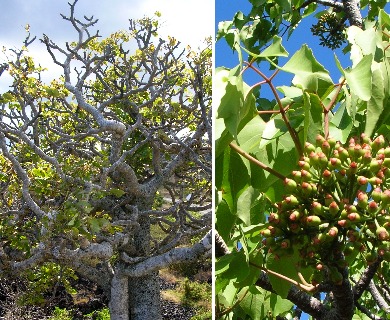`Ohe Makai
Polyscias sandwicensis
Ivy/Pennywort/Devil's Club family (Araliaceae)
Native species ()
This distinctive tree of dry forests is easily recognized by its stout smooth, light gray trunk with spreading of stout crooked branches, clear yellow brown tasteless resin, and large leaves with 7–11 wavy margined heart-shaped at base. Also, many small greenish flowers in large branched clusters are conspicuous mostly in early spring while the tree is leafless.

©2005 Forest And Kim Starr
Leaves crowded at end of twig, 10–12 inches (25–30 ) long, powdery hairy when young, becoming hairless, with slender light green axis enlarged and almost clasping at base and ringed at base of mostly 7–11, paired except at end, hairless, on slender stalks of 3⁄8–1 inch (10–25 ), broadly 2–4 inches (5–10 ) long and 1 1⁄4–3 1⁄4 inches (3–8 ) wide, blunt at heart-shaped at base, wavy margined, slightly thickened and fleshy, dull light green above, paler beneath.
Flower clusters () 1–3, 3–8 inches (7.5–20 ) long, with stout axis and many slender spreading branches, resinous. Flowers many, greenish, on short slender stalks, from elliptical green resinous buds more than 1⁄4 inch (6 ) long, composed of conical base () 1⁄8 inch (3 ) high, five tiny teeth, 8–10 narrow petals 1⁄4 inch (6 ) long, 8–10 spreading with petals, and with inferior of 8–10 cells, very short in thick and 8–10 dot stigmas in conical mass.
(berries) are rounded about 5⁄16 inch (8 ) in diameter, with stigmas at purplish, juicy, bitter, becoming dry with ridges. Seeds (nutlets) 10 or fewer, elliptical, flattened, 3⁄16 inch (5 ) long.
The soft whitish wood is not presently used. The Hawaiians made stilts from it for a game. The resin or gum was also used.
Scattered in dry lowland areas, especially aa or rough lava fields, to 2600 ft (792 ) elevation; becoming rare.
Special areas
Waimea Arboretum, Wahiawa, Volcanoes.
Champion
Height 48 ft (14.6 ), c.b.h. 6.7 ft (2 ), spread 23 ft (7 ). Puuwaawaa, Kailua-Kona, Hawaii (1968).
Range
This is found on Niihau, Oahu, Molokai, Lanai, Maui, and Hawaii, but is absent from Kauai.
Other common names
‘ohe-kukuluae‘o, ‘ohe
Botanical
Reynoldsia sandwicensis Gray, Reynoldsia degeneri Sherff, R. hillebrandii Sherff, R. hosakana Sherff, R. huehuensis Sherff, R. mauiensis Sherff, R. oblonga Sherff, R. venusta Sherff
In the broad sense this in Hawaii has a single variable species, though once divided into eight. A few others are found in Polynesia.






